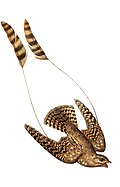| Nesophlox | |
|---|---|
 | |
| Bahama woodstar, (Nesophlox evelynae) | |
| Scientific classification | |
| Domain: | Eukaryota |
| Kingdom: | Animalia |
| Phylum: | Chordata |
| Class: | Aves |
| Clade: | Strisores |
| Order: | Apodiformes |
| Family: | Trochilidae |
| Tribe: | Mellisugini |
| Genus: | Nesophlox Ridgway, 1910 |
| Species | |
2, see text | |
| Synonyms | |
Calliphlox | |
Nesophlox is a genus in the family of Hummingbirds. It consists of two endemic hummingbirds of the Bahamas.










